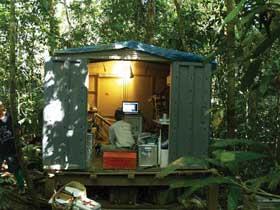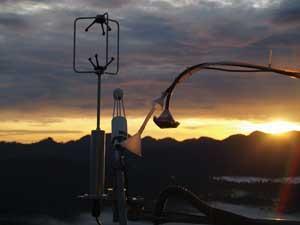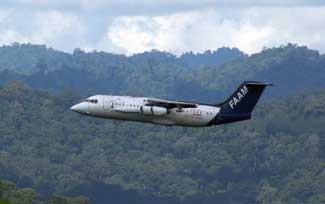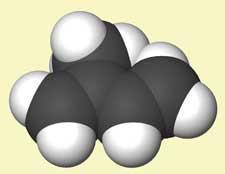Last summer a team of UK scientists dragged the contents of their lab out into the jungle, to analyse the local atmosphere. Emma Davies finds out what they discovered
Last summer a team of UK scientists dragged the contents of their lab out into the jungle, to analyse the local atmosphere. Emma Davies finds out what they discovered
’Orang-utans keep returning to the trees right next to the site for lunch and I saw some red leaf monkeys near the rest house recently. There is a herd of pygmy elephants close to the site now. If they get any closer we won’t be able to travel along the road alone.’ PhD chemist Kate Furneaux’s blog, dispatched from the depths of Borneo’s rainforest, provides a snapshot of what life was like for atmospheric scientists working on a project called OP3 (oxidant and particle photochemical processes) above a south-east Asian tropical rain forest.

During the 2008 summer, a large UK team from eight institutions escaped the monotony of lab life when they packed their equipment into large shipping containers and headed for Malaysian Borneo for OP3. On arrival, the researchers found themselves in a terribly humid, insect-infested environment, with the kind of animal sightings generally reserved for safari-goers. For those destined to work in the canopy, avoiding the blood-sucking leeches that ambushed them as they walked through the forest would become a daily ritual. Giant spiders joined round-table science meetings and poisonous snakes made themselves at home in the living quarters.

Despite the frequent failure of the delicately tuned lab equipment - designed for use in air-conditioned labs - the team collected some important data. Many of these are still being analysed but preliminary results suggest that increased industrialisation, together with the common Malaysian practice of replacing rainforest with oil palm plantations, could increase levels of tropospheric ozone, an important greenhouse gas.
Atmospheric action
What makes Borneo so interesting to study is that it is in the Tropics, a region often described as the atmosphere’s ’engine house’. Here, chemicals released from plants and trees react rapidly with other atmospheric compounds in the bright sunlight and high humidity. The Tropics remove up to 80 per cent of the greenhouse gas methane from the planet and the region plays a key role in determining global ozone levels.
Nick Hewitt, professor of atmospheric chemistry at Lancaster University, UK, leads OP3. There is strong evidence, he explains, that chemicals in the Tropics are rapidly transported from the atmosphere’s boundary layer (the lowest kilometre) into the upper troposphere and possibly into the stratosphere, so that the region has a ’disproportionately large’ effect on global atmospheric processes.
There is a strong case for monitoring the region’s atmospheric chemistry but until recently very few measurements had been taken. ’There’s a real paucity of data, partly because there’s no infrastructure,’ explains Dwayne Heard, professor of chemistry at the University of Leeds, UK, who heads an OP3 team. This contrasts with the situation in the Amazonian rainforests, where US groups have collected large amounts of data, many of which have been used to construct global climate models. However, south-east Asia’s complex mosaic of tropical seas and islands probably means that its atmospheric chemistry differs from that in continental Amazonia, says Hewitt.

OP3 has a real urgency because the chances to study undisturbed regions at low latitudes are diminishing rapidly as rainforests make way for crops. Like many tropical countries, Malaysia is giving over swathes of land to oil palm plantations.’They’re not cutting much undisturbed forest in Malaysia but where forest has previously been cut they’re now considering converting it to oil palm,’ says Hewitt.
Jungle story
Funded largely by the UK’s Natural Environment Research Council (Nerc), the OP3 team is studying atmosphere-biosphere interactions in Malaysian Borneo and predicting how these interactions might change in the future. Last year’s research campaigns were based at the Danum Valley Field Centre, in Sabah. This international research base, which is part-funded by the UK’s Royal Society, is set in a conservation area of pristine rainforest a few hours’ drive away from the nearest town.
OP3 is the work of eight UK teams from the universities of Lancaster, York, Manchester, Leicester, Leeds, Cambridge and East Anglia, and the Centre for Ecology and Hydrology in Edinburgh. An EU-funded group from the University of L’Aguila in Italy also takes part, as do several US-based scientists from Harvard, the Environmental Protection Agency and the National Center for Atmospheric Research. After a preliminary campaign in Borneo in April 2008 the teams started work in earnest with a month of intense activity last July. About 30 people collected data at the rainforest site while another 30 were involved in taking atmospheric measurements using the Nerc aircraft, BAE 146, a converted passenger jet packed full of lab equipment.
Teams on the ground (or up in the trees) measured large numbers of chemicals including volatile organic compounds (VOCs) and ozone. The site has a 100m high tower for collecting and analysing data. At its base is an air-conditioned lab run by the Malaysian Meteorological department. The OP3 researchers took some measurements up the tower but also rigged up a tube to transfer air sampled high up the tower to the makeshift labs at its base. Ben Langford, a post-doc at Lancaster, did most of his experiments at the tower, measuring VOCs using proton transfer reaction mass spectrometry (PTR-MS). ’Some of the kit was kept in aluminium boxes on the walkways around the tower but all of the expensive kit was either housed in shipping containers at the base of the tower or in the Met department labs,’ he says.
The PTR-MS caused a lot of headaches. ’We took three machines out with us and all three broke within half an hour,’ recalls Langford. ’It was all down to power fluctuations coupled with extreme humidity. It took us a lot of time and frantic telephone calls to the manufacturer to fix the problems.’
The research team bravely decided to take one of the bulky PTR-MS machines up into the forest canopy to measure VOC concentration profiles in the midst of all the foliage. This was no mean feat. First they had to build four tree platforms capable of holding large amounts of lab equipment. A team of eight people had to lug the 100kg PTR-MS a kilometre into the leech-infested jungle. Workers from a company called Canopy Access helped to construct the platforms but researchers from Edinburgh’s Centre for Ecology and Hydrology were responsible for setting up and maintaining the lab equipment, having been on the necessary tree-climbing courses. ’If something went wrong it was up to those guys to go up and check,’ says Langford.

’We were trying to get a picture of the chemistry from all sides - to see what was being emitted from the soil and from the tree canopy itself, and then tie that in with what we were seeing with our above-canopy and aircraft measurements,’ explains Langford. He is still analysing his PTR-MS data but the general observations are that VOC concentrations are much higher towards the top of the canopy where more sunlight can penetrate the dense foliage.
Flying high
Hewitt is reluctant to give away too many of the details of the OP3 work before journal publication but there are some clear-cut results. Measurements made at the tower didn’t throw out many surprises. ’The rainforest environment is obviously very, very clean so oxides of nitrogen [which come mainly from industrial processes and vehicles] are present at very low concentrations,’ says Hewitt. ’The forest itself gives off many volatile organic compounds but at fairly low levels. Ozone concentrations are also extremely low, partly because of the remoteness of the site and partly because ozone is lost by deposition to the forest canopy - molecules of ozone are destroyed on leaf surfaces.’
Because the rainforest is only about 50 miles away from the coast, the composition of the aerosol particles in the atmosphere is partly influenced by the ocean. ’There is quite a bit of sulfate present which comes from SO2 but also, importantly, from the oxidation of dimethyl sulfide emitted from the oceans,’ says Hewitt.
Data collected on the Nerc aircraft gave more of a worrying insight into the future. ’When the aircraft flew over the rainforest we saw similar things - relatively low ozone concentrations, low levels of oxides of nitrogen, and low particle loadings in the atmosphere,’ says Hewitt. ’But when the plane flew over the oil palm plantations we saw more VOCs and when it flew at low altitude through pollution plumes from processing mills in the oil palm plantations we were able to detect much higher particle concentrations and much higher concentrations of oxides of nitrogen.’
So what does this mean for the future? ’We need to use modelling activities to look at what will happen if that area of Malaysia becomes more industrialised and more oxides of nitrogen enter the atmosphere. There is the potential to form ozone because of the high levels of VOCs in the atmosphere,’ explains Hewitt.
At relatively low concentrations (80 parts per billion), ozone affects crop yield and can cause respiratory problems in humans. Current rainforest concentrations of this air pollutant are only 10-15 parts per billion, compared with about 30ppb in the UK.
Radical stuff
Of the VOCs, the terpenes such as isoprene (2-methyl-1,3-butadiene) - which accounts for about 40 per cent of biogenic VOC emissions - are probably the most important. Their carbon-carbon double bonds make them very reactive and oxidation reactions rapidly remove them from the atmosphere. They react with hydroxyl radicals (•OH) to form peroxy radicals (ROO•) which are responsible for ozone formation since they can oxidise nitric oxide to give nitrogen dioxide and RO•. Oxygen atoms then form in the presence of sunlight and these can combine with O2 to create ozone.

The hydroxyl radicals play a key atmospheric role but there are still large parts of their reaction profile that are undiscovered or not understood. The radicals are primarily created when the sun’s rays photodissociate ozone in the presence of water vapour. ’In the Tropics, you have the most sunlight and the most water vapour and so you would expect that that’s where the •OH concentrations are highest,’ says Heard, who led the OH team for OP3. So hydroxyl, known as the atmosphere’s cleanser, is thought to play a key role in the region’s chemistry.
It has long been thought that in unpolluted air, biogenic VOCs deplete •OH, reducing the oxidation capacity of the atmosphere and its ability to control levels of species such as methane that contribute to global warming. So in regions with high VOC levels you might expect lower hydroxyl concentrations.
’Models predict •OH globally but there are actually very few measurements to check the models with,’ says Heard. Recent •OH measurements haven’t matched model predictions. A 2005 study in Suriname, South America, by a team led by Jos Lelieveld at the Max Planck Institute for Chemistry, Mainz, Germany, measured •OH levels that far exceeded model predictions. Lelieveld’s team tweaked its models to accommodate the higher •OH levels and proposed that VOC oxidation actually recycles •OH in low NOx air through peroxy radical reactions.
Isoprene is key to the proposed recycling mechanisms. ’The discrepancies between the measurements and the models scaled with isoprene concentrations but this doesn’t mean that isoprene itself is causing the modelling problem,’ says Heard. ’It could be that other species, which scale with isoprene, cause the recycling.’
Alex Guenther, section head of the biosphere-atmosphere interactions group at the National Center for Atmospheric Research (NCAR), Boulder, US, is sceptical about some aspects of Lelieveld’s proposed recycling mechanism. ’There’s obviously something wrong with the chemistry but it hasn’t been figured out what’s going on,’ he says.

Heard’s team, although still analysing OP3 data, found lower •OH concentrations in Borneo that those recorded in the Amazon. His team uses a technique called Fluorecence Assay by Gas Expansion (Fage) - essentially laser-induced fluoresence at low pressure - to measure •OH. The researchers also measure how long hydroxyl survives before it reacts with another species - hydroxyl reactivity. This measurement involves photolysing water vapour in a flow tube to make •OH. The •OH is then exposed to rainforest air and the time that it takes to decay measured using laser-induced fluorescence. ’We can look at all the other things that we have measured, such as isoprene and other VOCs, and calculate how quickly the •OH should disappear. If we measure an •OH decay rate that is much faster than what we calculate from the other measurements it means that we are not measuring all of the things that react with •OH,’ explains Heard.
Early results from Borneo show the •OH to have a distinct daytime profile that follows isoprene quite closely. ’As the day warms up the trees start to emit more isoprene and the •OH survives for a shorter time because there is more isoprene to react with it. Our measured reactivity increases and then falls again as you get towards the afternoon when the isoprene emissions start to drop off,’ says Heard. However, when Heard’s team calculated •OH reactivity using measured isoprene concentrations the figures didn’t quite match up, implying that other species are also involved in removing •OH. ’We need a list of all the VOCs that were measured by OP3 groups so that we can add up the reactivity of each one and see how that compares to our measured reactivity. Until we do that we won’t know for sure how much reactivity is missing from models,’ says Heard. ’We assume that isoprene and a few other species dominate but there will of course be many other species. It’s a rich place in terms of emissions - I’m sure there will be lots of species that just won’t be measured.’
Accurate OH measurements and good working models are essential for researchers to be able to monitor the ability of the Tropics to remove something like methane. Existing •OH models have a lot of shortfalls, says NCAR’s Guenther. ’A lot of the reaction rates in the models are based on unrealistic things. The other problem is that in a lot of cases the models use the results of lab studies that just look at the first step: isoprene reacting with •OH. But hundreds of other compounds are also produced along the line as you go from isoprene to CO2. And these studies can’t simulate that - not the whole process - mostly just the first step.’
Model data
Computer models for relatively simple atmospheric processes feed into bigger climate change models. Getting the models right is vital to help predict what will happen as the climate changes. Such models are relied upon by governments around the world. ’One of the grand challenges for computation is climate. One of the large drains for models is putting the chemistry in and understanding things like methane and ozone, which, when combined, are about as important as CO2 to climate change,’ says Mat Evans, a modeller at the University of Leeds who works on OP3.
’The tropical rainforest is dominated by what’s given off by the trees. There’s a subtle feedback between climate and what these trees are doing. As the temperature increases, the trees will give off more hydrocarbons and their impact on the composition of the atmosphere will change. It’s a complicated modelling effort to try to understand the feedbacks between the biosphere and the atmospheric composition,’ adds Evans.

Because the atmosphere in the Tropics is so unstudied there are big gaps in the knowledge of how the hydrocarbons released by trees degrade. ’Trying to work out how to go from an emission of one species to an impact on methane or ozone levels is very complicated,’ says Evans. ’We constantly challenge the models with observations to find when the models do work.’
But even if they reach a stage where the models work perfectly, the researchers won’t be able to rest on their laurels. ’An instrument may come along that can measure a new species. We will always need to make as many measurements as possible,’ says Heard.
In any case, the modellers enjoy testing their models with real data. ’You’re torn between wanting the model to work and realising that actually the interesting science comes when the model fails,’ reveals Evans. ’The reality is that the interesting stuff comes when the model doesn’t work and when our pre-conceived ideas are proved to be wrong,’ he says. ’If we understood everything there would be no debate and we’d all be out of a job.’
Looking back
Did the OP3 team enjoy the Borneo experience? ’Last year almost killed us,’ jokes Heard. ’It was an extremely demanding project. The equipment took a real battering and it took a very long time getting it there and getting it back.’ Nevertheless he would ’welcome the opportunity to go back at some point.’
’I jumped at the chance to do this work,’ says Langford. And he wasn’t let down. ’It’s amazing how quickly you get to know people when you’re working so closely with them. There’s a good team spirit and everyone pulls together.’ This team spirit certainly shines through Furneaux’s blog. Without team spirit it’s hard to imagine the researchers coping with the myriad obstacles - animal and machine - put in their way.
Emma Davies is a science writer based in Bishop’s Stortford, UK
Further Reading
J Lelieveld et al, Nature, 2008, 452, 737






No comments yet